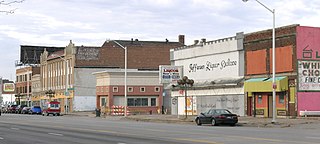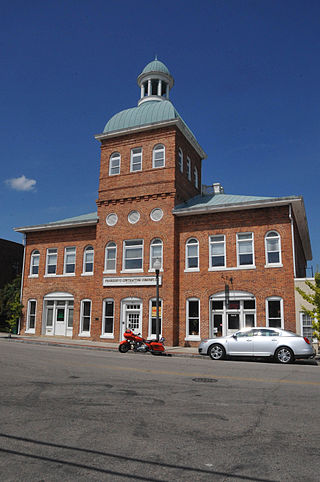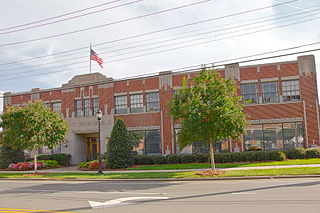
The Coca-Cola Bottling Plant is a historic manufacturing facility in the Evanston neighborhood of Cincinnati, Ohio. Constructed in the 1930s in high Streamline Moderne style, it no longer produces beverages, but has been named a historic site.

The Dixie Coca-Cola Bottling Company Plant, also known as Baptist Student Center, or Baptist Collegiate Ministry at Georgia State University, is a historic building at 125 Edgewood Avenue in Atlanta, Georgia. Built in 1891, it was the headquarters and bottling plant of the Dixie Coca-Cola Bottling Company, and the place where the transition from Coca-Cola as a drink served at a soda fountain to a mass-marketed bottled soft drink took place. It was declared a National Historic Landmark in 1983, and is one of the only buildings in Atlanta dating to Coca-Cola's early history. Since 1966 the building has been the Baptist Student Ministry location for Georgia State University.

The Coca-Cola Bottling Company Building, also known as the Kelly Press Building, is a historic commercial building located on Hitt Street in downtown Columbia, Missouri. It was built in 1935, and is a 1 1/2-story, Colonial Revival style brick building with a side gable roof with three dormers. It has a long one-story rear ell. Today it houses Uprise Bakery, Ragtag Cinema, Ninth Street Video, and Hitt Records.

The Elmira Coca-Cola Bottling Company Works is located at 415 West Second Street, Elmira, New York. It was built in 1939 in the Art Moderne style. The building was designed by architect Lucius Read White, Jr. The structure is significant for its architecture and its role in industry, and was added to the National Register of Historic Places in 1997.

The Jefferson–Chalmers Historic Business District is a neighborhood located on East Jefferson Avenue between Eastlawn Street and Alter Road in Detroit, Michigan. The district is the only continuously intact commercial district remaining along East Jefferson Avenue, and was listed on the National Register of Historic Places in 2004.

The Quincy Masonic Temple was a historic Masonic temple at 1170 Hancock Street, Quincy, Massachusetts. It was built in 1926 and added to the National Register of Historic Places in 1989. The building was home to three "Blue" Masonic Lodges, two Appendant Bodies: York Rite, Grotto, and two Youth Groups: DeMolay and Rainbow.

The United States Courthouse, also known as the Federal Building, is a historic building located in Davenport, Iowa, United States. It has historically housed a post office, courthouse, and other offices of the United States government. The building now serves only as a federal courthouse, housing operations of the eastern division of the United States District Court for the Southern District of Iowa. In 2018, the operations of the Rock Island division of the United States District Court for the Central District of Illinois were also moved there.

The U.S. Forest Service Building is a historic building within the Ogden Central Bench Historic District in Ogden, Utah, United States, owned by the United States federal government. Located at 507 25th Street, it is listed as a Historic Federal Building, and was constructed during the years 1933–1934. Its primary task was to provide offices for the U.S. Forest Service Intermountain Region, the Experimental Station, and the Supply Depot. The building was listed on the National Register of Historic Places in 2006.

The Quincy Street Historic District is a historic district located along the 100, 200, and 300 blocks of Quincy Street, along with 416 Tezcuco Street, in Hancock, Michigan. The Hancock Town Hall and Fire Hall is located in the district. The district was listed on the National Register of Historic Places in 1988.

The Coca-Cola Building is a Coca-Cola bottling plant modeled as a Streamline Moderne building designed by architect Robert V. Derrah with the appearance of a ship with portholes, catwalk and a bridge from five existing industrial buildings in 1939. It is located at 1334 South Central Avenue in Los Angeles, California. It was designated Los Angeles Historic-Cultural Monument Number 138 on 5 Feb 1975. It is often referred to as the Coke Building.

The Coca-Cola Building is a building located at 1322–1336 S. Wabash Ave. in the Near South Side community area of Chicago, Illinois, which once served as the Chicago headquarters of The Coca-Cola Company. The building was designed by Frank Abbott in the Commercial style and built from 1903 to 1904. When it opened, the building was eight stories high; two additional stories were added in 1913. The building features limestone with iron ornaments on its first two stories; a cornice with a terra cotta fretwork pattern at the top separates the second and third floors. The top of the building features a terra cotta frieze and a cornice with decorative patterns. The Coca-Cola Company operated out of the building from 1904 until 1928; the building was the company's second office outside of Atlanta. The building was the only Coca-Cola syrup manufacturing plant in the Midwest until 1915; it is now the only surviving Coca-Cola plant from before World War II outside of Atlanta.

The old Belvidere High School is a complex of four connected buildings that reflect three different architectural styles: Classical Revival, Prairie School, and Art Deco. It is composed of the 1893 Garfield School, a 1900 powerhouse, the 1916 Belvidere High School, and the 1939 Belvidere High School Auditorium & Gymnasium.

Winchester Coca-Cola Bottling Works is a historic Coca-Cola bottling plant located at Winchester, Virginia. It was built in 1940–1941, and is a two-story, reinforced concrete Art Deco style factory faced with brick. The asymmetrical four-bay façade features large plate-glass shop windows on the first floor that allowed the bottling operation to be viewed by the passing public. It has a one-story rear addition built in 1960, and a two-story warehouse added in 1974. Also on the property is a contributing one-story, brick storage building with a garage facility constructed in 1941. The facility closed in 2006.

Charlottesville Coca-Cola Bottling Works is a historic Coca-Cola bottling plant located at Charlottesville, Virginia. It was built in 1939, and is a two-story, reinforced concrete Art Deco style factory faced with brick. It has one-story wing and a detached one-story, 42-truck brick garage supported by steel posts and wood rafters. The design features stepped white cast stone pilaster caps, rising above the coping of the parapet, top the pilasters and corner piers and large industrial style windows. In 1955 a one-story attached brick addition was made on the east side of the garage providing a bottle and crate storage warehouse. In 1981 a one-story, L-shaped warehouse built of cinder blocks was added to the plant. The building was in use as a production facility until 1973 and then as a Coca-Cola distribution center until 2010.

Downtown Sanford Historic District is a national historic district located at Sanford, Lee County, North Carolina. It encompasses 53 contributing buildings in the central business district of Sanford. The district includes notable examples of Colonial Revival, Tudor Revival and Art Deco style architecture, with buildings largely dated between about 1895 to 1930. Located in the district are the separately listed Railroad House and Temple Theatre. Other notable buildings include the Sanford Buggy Company, McCracken Building, Passenger Depot, City Hall, Coca-Cola Bottling Company, Masonic Lodge, Makepeace Building (1924), Wilrick Hotel (1925), Bowers Building, Cole Pontiac Building, Hubbards Shoe Store (1926), Carolina Hotel (1930), and former U. S. Post Office.

Former Charlotte Coca-Cola Bottling Company Plant is a historic Coca-Cola bottling factory building located at Charlotte, Mecklenburg County, North Carolina. It was built in 1929–1930, and is a two-story, reinforced concrete building with a red brick veneer and decorative concrete detailing and Art Deco design elements. The building has a rectangular plan measuring 110 feet by 185 feet, parapet, and Coca-Cola bottles, sculpted of precast concrete, which crown the corner pilasters.

Coca-Cola Bottling Company Plant is a historic Coca-Cola bottling plant located at Bloomington, Monroe County, Indiana. The original section was built in 1924, and is a two-story, roughly square, red brick building. A one-story section was added in a renovation of 1938–1939, along with Art Deco style design elements on the original building. It closed as a bottling plant in 1989, and subsequently converted for commercial uses.
The Gadsden Coca-Cola Bottling Plant is a historic building in Gadsden, Alabama. It was built in 1929 by the Coca-Cola Company to replace a facility that had opened in 1915. In 1948–49, a two-story rear addition and one-story wing were built. The plant remained in use until 1987, when a new plant was built in the eastern part of town. The brick building is two stories, with a tile hipped roof and bracketed eaves. The original entrance features a stone surround with a keystone, but the door has since been replaced with a single-pane window. A similar entrance between the original block and the 1940s single-story addition which has scoring to imitate blocks and a Coca-Cola bottle carved into the lintel. The west elevation has a carved terra cotta sign with the Coca-Cola script logo. A separated auto garage and storage facility stands behind the main building, and is constructed of the same brick.

The Coca-Cola Syrup Plant is a former industrial building in St. Louis, Missouri that made soft drink concentrate for the Coca-Cola company. The National Register of Historic Places listed the structure which has since been converted to the residential Temtor Lofts.




















